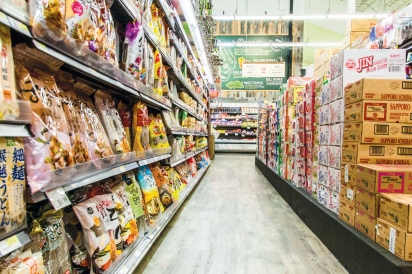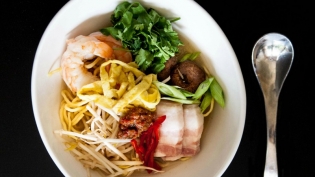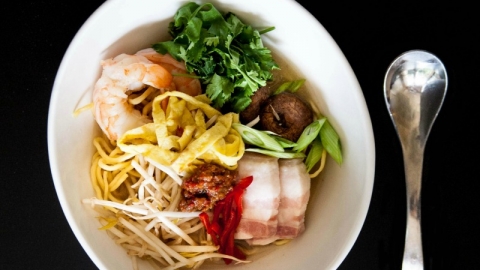Oodles of Sweet Longevity - Eat to Your Health!
Happy Birthday from Penang
Noodles go back a long way in history. In 2005, a team of archeologists discovered 4,000-yearold long, thin, yellow noodles beautifully preserved inside an overturned sealed bowl, buried under 10 feet of sediment in Qinghai, Northwestern China. In every East Asian culinary culture, noodles are associated with well-being and longevity—the length and continuity of noodles symbolize a long and healthy life.
A stroll down the noodle aisle of any large Asian supermarket in Houston, such as Jusgo Supermarket or Viet Hoa International Foods, reveals row upon row of noodles, stacked neatly on the shelves: fresh, fresh-frozen or dried, grouped according to the kinds of flour they are made of. The most common varieties are wheat (mein or mian) and rice (fun or fen), but we also have those made of mung bean and tapioca. The wide variety shows not only regional specialties but also provides for various textures and presentations. There are so many varieties from China, Thailand, Vietnam, Japan, Korea, Philippines, Malaysia and Indonesia, all with their own local names, representing the many languages and dialects of the region. This large array of noodles in all shapes, sizes and textures can be overwhelming but it becomes easy once a person becomes familiar with a few noodle dishes.
I grew up in the southern extreme of Far East, on the tropical island of Penang, in the Straits of Malacca, where the Chinese, Indian and Malay peoples met and have lived together for the past 500 years. Many of the Chinese in the older settlements of Singapore, Malacca and Penang along the Straits of Malacca have adopted to local customs to become a distinct community, giving birth to the signature Peranakan cuisine of Malaysia and Singapore with its unique blend of Chinese, Indian and Malay tastes. And from this melting pot of the East comes the Chinese fusion birthday noodle dish: Nyonya Lam Mee.
Nyonya Lam Mee reflects the excitement and vibrance of the South Seas. Coming from China, my late father always ate the more traditional and more austere wheat noodle soup on his birthday. In contrast, Nyonya Lam Mee is a riot of color with fresh yellow noodles immersed in a shrimp and bone stock soup topped with sliced meat, shredded omelets, sliced red chilies, shrimp, Chinese mushrooms, green onions and, most importantly, a dollop of dark red sambal belacan, a pungent chili paste made with dried shrimps that is a staple in Malaysian cuisine. The fresh yellow noodles or Lo Mein or Mi Phuoc Kien in Vietnamese, are made of wheat flour and eggs. Both Jusgo Supermarket and Viet Hoa International Foods carry the fresh loose oiled yellow noodles that are locally made in Texas, which come in two-pound packets. The noodles can be found refrigerated in the produce section.
Birthday celebrations are always complemented with a sweet dessert. I fondly remember my mother preparing the Nyonya Lam Mee noodles, two red-colored eggs and a red-hued sweet dessert called Kow Chan Kuih to bring abundant luck for the year on my birthday! In Chinese culture, eggs symbolize birth and life and red represents happiness. With their round shape, they connote a harmonious and happy life.
Kow Chan Kuih translates as nine layer cake. The Kuih (or cake) has nine layers, alternating pink and white with an orange-red top. It is often picked as a sweet dessert for luck on birthdays and festivals as the Chinese character for nine stands for completeness and eternity: It is the highest single-digit number in the base 10 numerical system used by the Chinese. Hence, emperors wore Nine-Dragon robes, and constructed palaces like the Forbidden City based on the number nine. The Kow Chan Kuih provides a harmonious sweet balance to any joyous occasion.
Some recommended supermarkets that carry a good selection of Southeast Asian and East Asian groceries
Viet Hoa International Foods is located just off Sam Houston Parkway and Beechnut Street at 8300 W. Sam Houston Parkway, Houston, 77072.
The Jusgo Supermarket is located on 9280 Bellaire Blvd., between Corporate Drive and Ranchester Drive, just off Beltway 8.
Pandan
In all Peranakan and indeed Southeast Asian desserts, the fragrant pandan leaf provides the essential differentiating ingredient. Pandan (Pandanus amaryllifolius) or screwpine is native to the tropics in Southeast Asia. The leaves are long, thin and blade-like. When bruised or knotted, it provides a distinct fragrance and adds character to a dish. Also known as the “Vanilla of the East," this leaf can also be used to provide a natural greenish coloring. To extract the color, pound or pulverize the leaves in a blender with just enough water and then strain. Pandan leaves are sold in every Asian supermarket in town, in the fresh vegetable section or in the frozen cases. It is also sold as a potted plant right here in Houston, and indeed can even be planted outdoors. Pandan potted plants can be found in the JRN Nursery situated at Alief Clodine Drive and Westpark Tollway, south of Westheimer.








